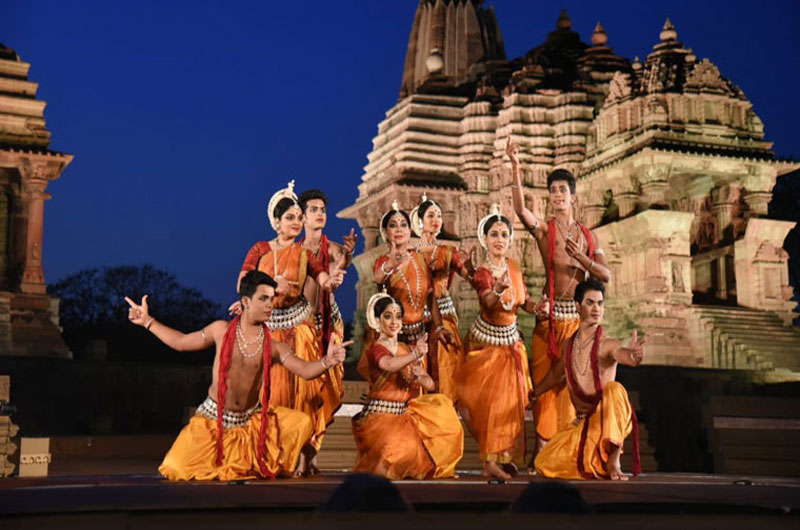
Festivals of Madhya Pradesh: A Symphony of Tradition and Culture
Madhya Pradesh’s festivals reflect its rich cultural heritage, deep-rooted traditions, and vibrant community life. Each festival, with its unique customs and celebrations, offers a glimpse into the colorful and dynamic heritage of this central Indian state.
1. Lokrang Festival
Time of Festival
- Celebrated in January, typically around Republic Day.
Specialty of the Festival
- Showcases the rich cultural heritage and folk traditions of Madhya Pradesh.
- Features folk dances, music performances, art exhibitions, and craft fairs.
- Highlights include performances by tribal artists and craftsmen from across the state.
Locality of the Festival
- Celebrated in Bhopal, the capital city of Madhya Pradesh.
Nature of the Festival
- Cultural and traditional.
- Emphasis on folk traditions, art, and crafts.
- Features cultural performances, exhibitions, and community gatherings.
2. Tansen Music Festival
Time of Festival
- Celebrated in December.
Specialty of the Festival
- Honors the legendary classical musician Tansen, one of the nine jewels in Emperor Akbar’s court.
- Features performances by renowned classical musicians from across India.
- Held at Tansen’s tomb, creating a serene and historical ambiance for the festival.
Locality of the Festival
- Celebrated in Gwalior, at the tomb of Tansen.
Nature of the Festival
- Cultural and musical.
- Emphasis on classical music heritage and honoring Tansen’s legacy.
- Features classical music performances and cultural gatherings.
3. Khajuraho Dance Festival
Time of Festival
- Celebrated in February or March.
Specialty of the Festival
- Showcases classical dance forms like Kathak, Bharatanatyam, Odissi, and Kuchipudi.
- Held in the backdrop of the magnificent Khajuraho temples, enhancing the cultural experience.
- Attracts renowned dancers and cultural enthusiasts from around the world.
Locality of the Festival
- Celebrated in Khajuraho, a UNESCO World Heritage Site.
Nature of the Festival
- Cultural and artistic.
- Emphasis on classical dance heritage and the architectural splendor of Khajuraho.
- Features dance performances, cultural exhibitions, and community gatherings.
4. Bhagoria Haat Festival
Time of Festival
- Celebrated in March, a week before Holi.
Specialty of the Festival
- A tribal festival celebrated by the Bhil and Bhilala tribes.
- Features traditional dance, music, and a unique matrimonial custom where young people choose their life partners.
- Vibrant markets (haats) are set up, selling tribal crafts, food, and jewelry.
Locality of the Festival
- Predominantly celebrated in the Jhabua and Alirajpur districts.
Nature of the Festival
- Cultural and traditional.
- Emphasis on tribal traditions, community bonding, and matrimonial customs.
- Features markets, dances, music, and festive celebrations.
5. Pachmarhi Utsav
Time of Festival
- Celebrated in December.
Specialty of the Festival
- A cultural festival showcasing music, dance, and local arts.
- Includes performances by folk artists, classical musicians, and dancers.
- Also features craft fairs, food stalls, and cultural exhibitions.
Locality of the Festival
- Celebrated in Pachmarhi, the only hill station in Madhya Pradesh.
Nature of the Festival
- Cultural and artistic.
- Emphasis on local arts, music, and community engagement.
- Features performances, exhibitions, and festive activities.
6. Malwa Utsav
Time of Festival
- Celebrated in May.
Specialty of the Festival
- Highlights the rich cultural heritage of the Malwa region.
- Features folk dances, music performances, craft fairs, and traditional cuisine.
- Includes performances by artists from across India, promoting cultural exchange.
Locality of the Festival
- Celebrated in Indore and Ujjain.
Nature of the Festival
- Cultural and traditional.
- Emphasis on regional traditions, arts, and community celebration.
- Features cultural performances, exhibitions, and community gatherings.
7. Dusshera
Time of Festival
- Celebrated in October, marking the end of Navaratri.
Specialty of the Festival
- Symbolizes the victory of good over evil, commemorating Lord Rama’s victory over Ravana.
- Features grand processions, effigy burning of Ravana, and theatrical performances (Ramlila).
- Each region has unique customs and ways of celebrating the festival.
Locality of the Festival
- Celebrated across Madhya Pradesh, with significant celebrations in Kullu, Jabalpur, and Ujjain.
Nature of the Festival
- Religious and cultural.
- Emphasis on community bonding, tradition, and spiritual significance.
- Features processions, performances, and festive activities.
8. Holi
Time of Festival
- Celebrated in March, marking the arrival of spring.
Specialty of the Festival
- Known as the festival of colors, involving playful throwing of colored powders and water.
- Features traditional songs, dances, and community feasts.
- Symbolizes the victory of good over evil and the end of winter.
Locality of the Festival
- Celebrated across Madhya Pradesh, in both urban and rural areas.
Nature of the Festival
- Cultural and religious.
- Emphasis on joy, community bonding, and the celebration of spring.
- Features color throwing, dances, music, and feasts.
9. Diwali
Time of Festival
- Celebrated in October or November.
Specialty of the Festival
- Known as the festival of lights, marking the return of Lord Rama to Ayodhya.
- Homes are decorated with oil lamps, rangoli, and fireworks.
- Includes the exchange of sweets, gifts, and festive meals.
Locality of the Festival
- Celebrated across Madhya Pradesh, in both urban and rural areas.
Nature of the Festival
- Cultural and religious.
- Emphasis on light, prosperity, and family bonding.
- Features lighting of lamps, fireworks, feasts, and community celebrations.
10. Navaratri
Time of Festival
- Celebrated in September or October, lasting for nine nights.
Specialty of the Festival
- Devoted to the worship of the goddess Durga and her nine forms.
- Features fasting, prayers, and traditional dance forms like Garba and Dandiya.
- Temples and homes are decorated, and community events are organized.
Locality of the Festival
- Celebrated across Madhya Pradesh, with major celebrations in cities like Ujjain and Indore.
Nature of the Festival
- Cultural and religious.
- Emphasis on devotion, tradition, and community participation.
- Features prayers, dances, and festive gatherings.
